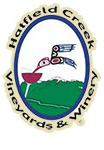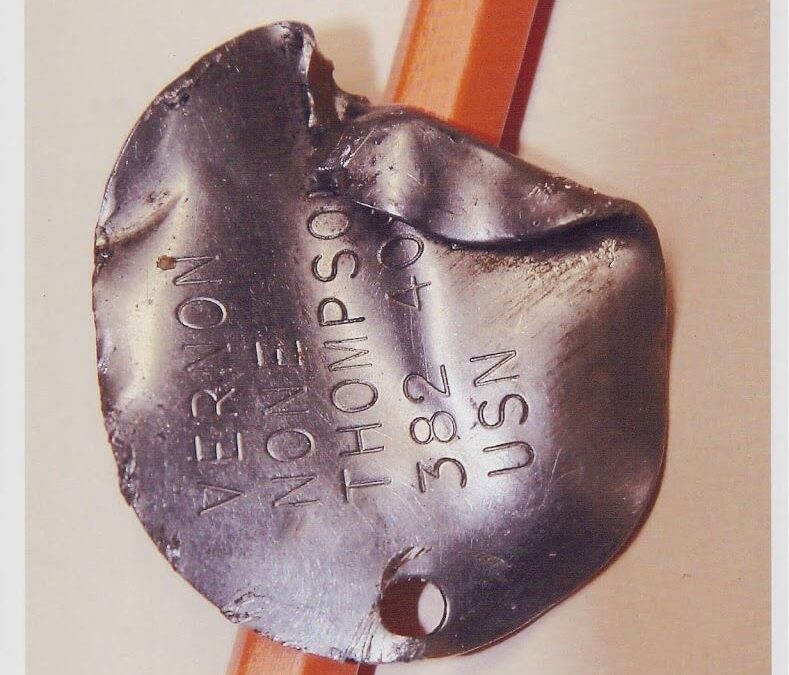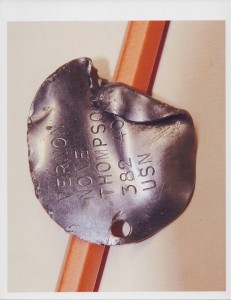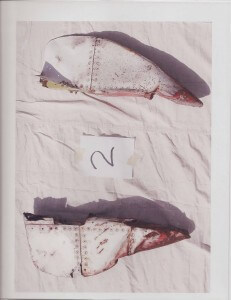
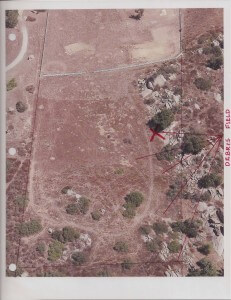
__________________________________________________________________
__________________________________________________________________
He wasn’t even supposed to fly that day. The flight instructor who was scheduled to conduct a training exercise in the Grumman F9F-8T “Cougar” on January 17, 1961, had a family emergency so Navy LCDR Vernon Thompson was called in to take his place. Something went seriously wrong, and Thompson and his student were both killed when the aircraft slammed in to the ground at Latitude 33 degrees, 2.6 minutes North, Longitude 116 degrees, 49.7 minutes West in Ramona.
When the crash site property changed hands in 2006, the new owners began clearing and tilling the field in preparation for the planting of their wine grape vineyard. Norm Case, one of the property owners and a pilot and airplane owner himself, began finding parts and pieces of the aircraft. He recognized them as being from a military plane, but could find no information locally on why they were there. He eventually found one neighbor who had lived in the area for decades, who mentioned a navy jet crash in the late 50’s or early 60’s.
Being busy with the new vineyard project, no other investigations were done until after October 2007. The Witch Creek Fire blew right through the crash debris area, and during the subsequent clean up, a new and touching piece of history was revealed – the pilot’s dog tag. A visit to the San Diego Archeological Society in San Pasqual Valley and research by an experienced staffer led to a connection to the Navy.
The government keeps track of all ships, planes and personnel that have ever been lost. The “Stricken Aircraft Program Manager”, Naval Inventory Control Point in Philadelphia contacted the property owners and the Navy began their investigations of the incident, including efforts to locate any next of kin of the downed pilot, Vernon Thompson whose dog tag had been found. The majority of the plane was recovered immediately after the crash, but the body of the pilot was never recovered. The discovery of the dog tags prompted the further investigations.
The Navy’s original accident report documenting the crash states that the 36 year old pilot flight instructor, LCDR Vernon Thompson “was an exceptionally conscientious aviator with a fervent desire to preserve his units safety record.” The report further went on to state, “He was cautious to the point of being too cautious and any experiment with a student in the rear seat would have been entirely ‘out of character’.”
The F9F-8T took off from NAS Miramar at about 0935U (9:30 a.m.) that day on a simulated, round robin training flight back to Miramar via Tacan (tactical air navigation) route direct to March AFB, Norton, Long Beach and Oceanside, where a simulated CCA (carrier control approach) was to be made, and thence to Miramar. At about 1030U the aircraft was observed by Ramona residents, just south of the city at low altitude and moderate airspeed, heading in a northeasterly direction. It continued east for about 2 ½ miles in a slight right turn and then pitched into a steep dive and crashed into the rocky terrain. Explosion occurred on impact.
While LCDR Thompson crashed with his aircraft and his body was never recovered, his co-pilot, 23 year old ENS Dennis F. Cubbison ejected from the rear seat just before the crash. However, he was fatally injured upon contact with the ground when his parachute failed to open. The accident report elaborates, “The aircraft hit the ground in an uncontrolled condition at the base of a flat ‘house sized’ boulder.” The impact forces, combined with ricochet and explosion of 3,000 pounds of JP-4 fuel, totally destroyed the aircraft. Fragments were found more than 350 yards away, and grass fires were started throughout the area, which were contained by State Forestry Fire Fighters.
A Grumman Field Representative and a Naval Aviation Safety Center Investigator noted that the destruction was so complete that of the many instruments in the aircraft, only two could be identified. The canyon itself made the recovery of parts difficult due to the many holes and crevices down through the boulders.
The current owners of the crash site property collected more than 350 small pieces of the craft which included door hinges, shell casings, pieces of the canopy plexiglass, seat belt buckles, an hydraulics servo unit, an alternator nomenclature plate, and the largest items, which were the two wing tips. All these were turned over to the Navy in April of 2009, along with the dog tag though pieces of debris are still being collected on a regular basis by the vineyard owners grandchildren.
Witnesses from the Ramona area were interviewed at the scene of the crash and as far back along the flight path as investigators considered practicable. These witnesses included a group of high school students, a woman watering her lawn, and a retired paratrooper who offered some well qualified testimony. The accident report stated it was noteworthy that many of the available witnesses with a commanding view of the aircraft’s flight path did not see or hear anything prior to a point 2 1/12 miles from the crash scene.
The Navy sent a team to the site in July of 2009 to conduct an archaeological evaluation of the crash site. No other parts of any significance were recovered nor any human remains. In the final analysis, the exact cause of the accident has remained undetermined. However the accident history of the F9F flying tail series is replete with accidents involving the longitudinal control system. The report states, “Of poor basic design, it contains several pilot traps in case of malfunction.”
The vineyard owners have had a plaque made which will be placed at the crash site in a ceremony on Veteran’s Day 11/11/2010. The Navy Stricken Aircraft Program Manager has contributed to the memorial and hopes to be in attendance for the dedication.
